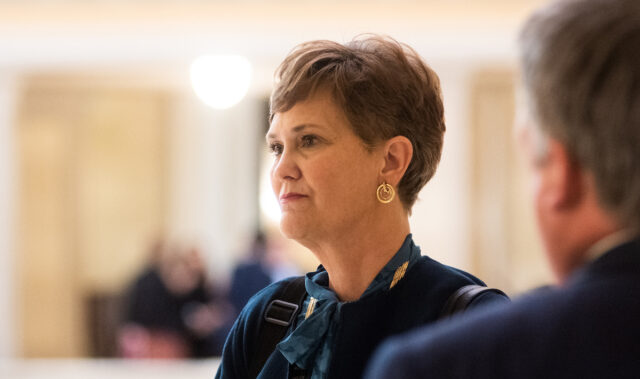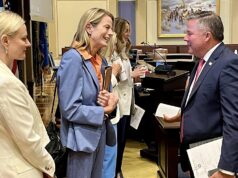

Late Tuesday, Oklahoma Chancellor Allison Garrett announced her plan to resign from the state’s top higher education position in January, about three years after she became the first woman to serve in the role.
“Serving the people of Oklahoma and working collaboratively with our state regents, elected officials, campus personnel, and business and community partners to help move this great state forward has been an honor,” Garrett said. “As I look ahead to a career capstone opportunity to complete an international project in late fall and the prospect of spending more time with family, I am filled with gratitude for the privilege to serve as chancellor and to work to make a positive impact on both Oklahoma’s workforce and in the lives of individual students across this state.”
Garrett, 60, was chosen by the State Regents for Higher Education in September 2021 to lead the State System for Higher Education. Before her hire, Garrett was the president of Emporia State University, a regional school in eastern Kansas. She holds an English degree from Oklahoma Christian University, a master’s of law from Georgetown University and a juris doctorate from the University of Tulsa College of Law.
“I’m grateful for Chancellor Garrett’s service,” Oklahoma Gov. Kevin Stitt said in a statement. “I want to extend my congratulations on her next endeavor. I’m looking forward to seeing what’s next for the Oklahoma State System of Higher Education as we continue to work toward the vision of being a top-10 state.”
Garrett also had leadership positions with Walmart, serving as a vice president and general counsel for the retail corporation. When she was hired, Stitt touted Garrett’s private sector experience.
“You always have to be growing. That’s where Allison comes in,” Stitt said at the time. “I’m confident she can help us grow in Oklahoma. Her background and experience are perfect to help lead a new era of higher education in Oklahoma.”
Garrett’s agency is governed by a nine-member board, each member of which is appointed by the governor to serve nine-year terms. Stitt has appointed seven of those members, including all who serve in a leadership position. Five members of the board issues laudatory statements about Garrett in Tuesday’s press release.
“We thank Chancellor Garrett for her tireless service and advocacy on behalf of Oklahoma’s higher education system,” said new board Chairman Dennis Casey. “Under her leadership, we developed Blueprint 2030, our comprehensive strategic plan to advance public higher education.”
Regents are expected to conduct a national search for Garrett’s successor. In his statement, Casey said Garrett helped increase college graduation numbers, update policies and create a committee about artificial intelligence.
“We respect her decision and the time she is providing that will allow us to develop and execute a succession plan,” Casey said.
Former board chairman and former Oklahoma House Speaker Jeff Hickman praised Garrett for improving relationships within the Legislature, which increased state funding for higher education in recent years and approved a massive program to addressed deferred maintenance this spring.
“Chancellor Garrett and her team worked in partnership with legislators to achieve historic investments to finally begin addressing mounting deferred maintenance projects at campuses across our state, as well as funding to equip students with degrees to meet Oklahoma’s career needs of the future and to keep the cost of those degrees for students and their parents as affordable as possible,” Hickman said. “In numerous areas, she will leave Oklahoma’s system of higher education stronger than she found it, and I am confident she will hand our higher education agency off to the next Chancellor in a position of strength.”
Consolidation conversations mostly still in starting blocks
Garrett’s departure as chancellor comes as the State Regents for Higher Education continues conversations about potential mergers among smaller institutions in its system. In March, regents met in both Wilburton and Poteau for discussions with the individual boards of regents for Eastern Oklahoma State College and Carl Albert State College.
The two eastern Oklahoma colleges are less than an hour’s drive away from each other and serve about 4,000 students combined each year. The Wilburton and Poteau meetings came in the same month that state regents gathered for a special meeting to discuss Garrett’s “annual employment review” during executive session. No votes were taken at the meeting, but Garrett was rumored at the time to have interest in a job consulting for higher education institutions.
Across the country, higher education experts are anticipating a significant “enrollment cliff” to shrink student bodies — and tuition revenues — over the next five to 10 years. As the population of traditional college-age Americans constricts, institutions and higher education systems have discussed sharing administrative services and governance structures as a way to align for survival and avoid competition and programmatic duplication.
But in the three years since Garrett succeeded former Oklahoma House Speaker Glen Johnson as chancellor, consolidation and efficiency efforts were limited. Redlands Community College and the University of Science and Arts Oklahoma in Chickasha — which has fewer than 850 students and has seen its enrollment decline by nearly 50 percent over the past 15 years — merged some administrative functions and aligned certain programs.
Meanwhile, Oklahoma has 25 public colleges and universities with 48 campuses, plus the University Center at Ponca City. The 25 individual entities are overseen by numerous governing boards that feature more than 150 total regent positions appointed by the governor.
Johnson served as chancellor from 2007 through 2021, parlaying the COVID-19 pandemic into two additional years in the prominent post after Stitt had attempted to replace him early in his first term as governor.
Among Oklahoma’s convoluted higher education landscape is the Regional University System of Oklahoma, a set of six former teacher colleges serving swaths of the state under a single governing board. RUSO schools have faced significant presidential turnover in recent years, and in late June the board named Brandon Tatum as the system’s new CEO.
“The Regional University System has done an amazing job of preparing students for the workforce and making sure their curriculum aligns with industry needs,” Tatum said in a press release.
In November 2022, Tatum left Oklahoma Christian University to become Stitt’s chief of staff.
“I appreciate my time in the governor’s office and I have loved being a part of his Top 10 vision for this state,” Tatum said. “I look forward to continuing to work with all the key stakeholders across the state as we make our higher education system the best in the nation.”
Earlier Tuesday, Stitt’s office announced Grayson Walker as the governor’s new chief of staff. An attorney, Walker clerked for Judge Thomas E. Prince of the Oklahoma Court of Civil Appeals before joining the Stitt administration as deputy general counsel.




















